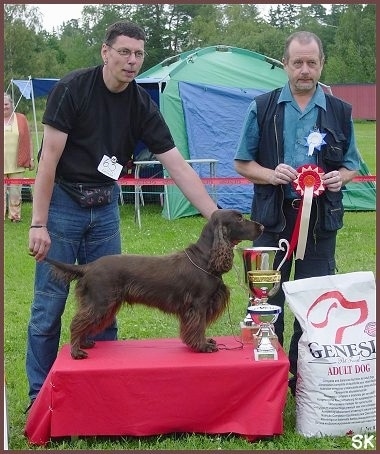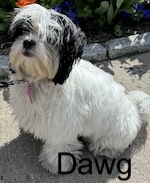Tilly aka Bramast Glenmorhan the Field Spaniel, bred and owned Michele Elliott
feeld span-yuh 
The Field Spaniel is a medium-sized dog. The skull is slightly wider in the back than it is in the front. The muzzle is strong, long and lean, with a moderate, but well-defined stop. The large nose is light brown to dark brown to black, depending on the coat color of the dog. The teeth meet in a scissors or level bite. The medium-sized eyes are almond in shape, dark hazel to brown in color. The medium-length ears are set slightly below the eyes, and wide, hanging close to the head with lots of feathering. The neck is strong and muscular. The tail is set low and is either docked or left natural. Note: docking tails is illegal in most parts of Europe. Dewclaws are sometimes removed. The single-layer coat is flat or slightly wavy and is of medium length with feathering on the chest, underside, back of the legs, buttocks, and may be on the second thigh and bottom of the tail. Coat colors come in black and various shades of liver, with or without tan markings or roan (speckles). There may be a little white on the chest.
Field Spaniels are active, robust hunting dogs that have very pleasing temperaments. They are very independent in nature, but easygoing, charming, affectionate, intelligent and playful. They make an excellent family member as long as they are given regular exercise and leadership. They are especially known for their docile nature. Socialize this breed well and be its strong, calm, confident pack leader to avoid timidity, reservations with strangers, and problems with other dogs. Very friendly, this breed loves everyone. Field Spaniels like to roam. They are good with other dogs, animals and excellent with children, but tend not to like super rough play. If they sense their owners are meek or passive they can become a bit stubborn and temperamental. Field Spaniels are happiest when they have a job to do. They are quick to learn and react very strongly to your voice. They should be trained with a kind but consistent manner. This dog has a sensitive nature and harsh words and a tough approach will greatly disturb it. These dogs need regular contact with people and become extremely neurotic if locked away in a kennel.
Height: average 18 inches (46 cm)
Weight: 35 - 50 pounds (16 - 22.5 kg)
Prone to hip dysplasia and ear infections.
The Field Spaniel is not recommended for apartment life. They are moderately active indoors and do best with at least a large yard. Because these dogs do have deeply rooted hunting instincts, it is essential to have a good fence surrounding your property, as otherwise they are likely to take off after any interesting scent. Do not lock this breed away in a kennel or it will become extremely neurotic. This breed prefers cool climates.
The Field Spaniel is primarily a working field dog which means that it really needs lots of exercise, and a sporty family suits it best. It will be happiest when given a chance to run and explore. But be aware that the Field Spaniel likes to follow its nose. It will however, adapt effortlessly to the family situation. Its needs can be met with daily long walks on a leash where the dog is made to walk beside or behind the person holding the lead, as instinct tells a dog the leader leads the way, and that leader needs to be the human.
About 10-12 years.
About 4 to 6 puppies
The Field Spaniel should be brushed and combed once or twice a week. Straggling hair should be scissored every few months. The ears should be kept clean. For show dogs, you usually need to visit a professional groomer about four times a year. Dead hair is removed by plucking; hair on the ears, legs, and neck is also thinned out.
Originating in England in the 1800s, the Field Spaniel used to be considered the same breed as the English Cocker Spaniel. The dog was used to flush and retrieve both fur and feather from land and water. In the 20th century it was decided that anything above 25 pounds would be considered a Field Spaniel and anything below would be an English Cocker Spaniel, and the two were officially separated into different breeds. During the 1800s the Field Spaniel was being bred with a greatly exaggerated length and weight. Almost a hundred years later in the 1920s, the standard returned to a moderate length and weight. Although it is a fine bird dog with a great, mild disposition, the breed remains rare to this day, most likely due to the extreme popularity of the Cocker Spaniel. The Field Spaniel was recognized by the AKC in 1894. Some of the Field Spaniel's talents are tracking, hunting, retrieving and watchdog.
Gun Dog, AKC Sporting Group
Tilly aka Bramast Glenmorhan the Field Spaniel, bred and owned Michele Elliott
Darcy, a young black Field Spaniel puppy

World Winner 2000 and 2002, European Winner 2000 etc., Iitu-Marin Sandra, female, 6 years old, photo courtesy of Sanna Korpela FIN
